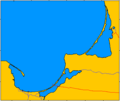Difference between revisions of "AY Honors/Geology/Answer Key"
From Pathfinder Wiki
| Line 27: | Line 27: | ||
;h. Alluvial fan: An alluvial fan is a fan-shaped deposit formed where a fast flowing stream flattens, slows, and spreads typically at the exit of a canyon onto a flatter plain. | ;h. Alluvial fan: An alluvial fan is a fan-shaped deposit formed where a fast flowing stream flattens, slows, and spreads typically at the exit of a canyon onto a flatter plain. | ||
| − | [[Image:Anticline.jpg|thumb|An ''anticline''' on the left, a '''syncline''' on the right.]] | + | [[Image:Anticline.jpg|thumb|250px|An '''anticline''' on the left, a '''syncline''' on the right.]] |
;i. Anticline: An anticline is an upward-curving fold, with layers that rise from the center of the structure. | ;i. Anticline: An anticline is an upward-curving fold, with layers that rise from the center of the structure. | ||
;j. Syncline: A syncline is a downward-curving fold, with layers that dip toward the center of the structure. It's easy to remember which is an anticline and which is a syncline, because the syncline "sinks" in the middle. | ;j. Syncline: A syncline is a downward-curving fold, with layers that dip toward the center of the structure. It's easy to remember which is an anticline and which is a syncline, because the syncline "sinks" in the middle. | ||
| + | <br style="clear:both"> | ||
==2. Describe the following:== | ==2. Describe the following:== | ||
Revision as of 01:34, 22 April 2007
1. Give the geological meaning of the following words:
- a. Delta
- A delta is a landform where the mouth of a river flows into an ocean, sea, desert, estuary or lake.
- b. Sand spit
- A spit a deposition landform found off coasts. A spit is a type of bar or beach that develops where a re-entrant occurs, such as at a cove, bay, ria, or river mouth. Spits are formed by the movement of sediment (typically sand) along a shore
- c. Sinkhole
- A sinkhole is a natural depression or hole in the surface topography caused by the removal of soil or bedrock, often both, by water. Sinkholes may vary in size from less than a meter to several hundred meters in diameter and depth, and vary in form from soil-lined bowls to bedrock-edged chasms. They may be formed gradually or suddenly, and are found worldwide.
- d. Oxbow lake
- n oxbow lake is a type of lake which is formed when a wide meander from a stream or a river is cut off to form a lake. They are called oxbow lakes due to the distinctive curved shape that results from this process. In Australia, an oxbow lake is called a billabong.
- e. Moraine
- Moraine is a French word that refers to any glacially formed accumulation of unconsolidated debris. This debris may be plucked off the valley floor as a glacier advances or fallen off the valley walls as a result of frost wedging. Moraine may be comprised of silt like glacial flour to large boulders. The debris is typically angular. Moraine may be on the glacier’s surface or deposited as piles or sheets of debris where the glacier has melted. Moraine may also occur when rocks fall in the sea.
- f. Cirque
- A cirque is an amphitheatre-like valley (or valley head) of glacial origin, formed by glacial erosion at the head of the glacier. Cirques are typically partially surrounded by steep cliffs. The highest cliff is often called a headwall. They are also known as a cwm in Wales, a coomb or coombe in England, and a corrie in Scotland and Ireland.
- g. Mesa
- A mesa (Spanish and Portuguese for "table") is an elevated area of land with a flat top and sides that are usually steep cliffs. It takes its name from its characteristic table-top shape. It is a characteristic landform of arid environments, particularly the southwestern United States. Many examples are also found in Spain, North and South Africa, Arabia, India, Australia, and the Badlands and Colorado regions of North America.
- h. Alluvial fan
- An alluvial fan is a fan-shaped deposit formed where a fast flowing stream flattens, slows, and spreads typically at the exit of a canyon onto a flatter plain.
- i. Anticline
- An anticline is an upward-curving fold, with layers that rise from the center of the structure.
- j. Syncline
- A syncline is a downward-curving fold, with layers that dip toward the center of the structure. It's easy to remember which is an anticline and which is a syncline, because the syncline "sinks" in the middle.









